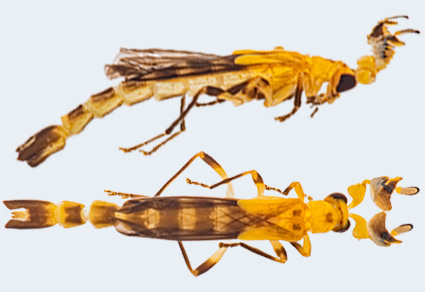Abstract
The genus Pseudocerocoma Pic, 1919 (Coleoptera: Cantharidae: Ichthyurini) was previously recognized as a monotypic genus. Based on material from Antioquia, Colombia, we describe and illustrate Pseudocerocoma tulenapa sp. nov. It differs from the other known species of the genus in the shape of the antennae and the abdominal segment 8, as well as in some aspects of coloration. This new species provides additional evidence for the position of Pseudocerocoma Pic, 1919 as a separate genus from Malthoichthyurus Pic, 1919, also represents the first record of the tribe Ichthyurini in Colombia and shows the importance of the conservation actions carried out in the only known locality, the Tulenapa Biological Station of the Universidad de Antioquia.
References
- Botero, J.P. & Biffi, G. (2021) Listado de las especies de Cantharidae (Coleoptera: Elateroidea) de Colombia 153 records. Available from: https://doi.org/10.15472/l1vnio (accessed 16 January 2024)
- Brancucci, M. (1979) Revision du genre Belotus Gorham (Col. Cantharidae). Entomologica Basiliensia, 4, 361–430.
- Brancucci, M. (1980) Morphologie comparée, évolution et systématique des Cantharidae (Insecta: Cantharidae). Entomologica Basiliensia, 5, 215–388.
- Brancucci, M. (1986) The genus Pseudocerocoma Pic (Coleoptera: Cantharidae). The Coleopterists Bulletin, 40, 141–144.
- Champion, G.C. (1915) II. Revision of the Mexican and Central American Telephorinae (Fam. Telephoridae), with descriptions of new species. Transactions of the Royal Entomological Society of London, 63, 16–146. https://doi.org/10.1111/j.1365-2311.1915.tb02520.x
- Delkeskamp, K. (1977) Pars 165. Fasc. 1. Editio seconda. Cantharidae. In: Wilcox, J.A. (Ed.), Coleopterorum Catalogus Supplementa. Junk, W., The Hague, pp. 1–485.
- GBIF.org (2023) GBIF Occurrence Download. Available from: https://doi.org/10.15468/dl.zvm77m (accessed 28 November 2023)
- Gorham, H.S. (1881) Biologia Centrali-Americana. Insecta, Coleoptera, Lycidae, Lampyridae, Telephoridae, Lymexylonidae, Melyridae. Series 3. Vol. 2. Taylor & Francis, London, 100 pp.
- Holdridge, L.R. (1967) Life zone ecology. Tropical Science Center, San Jose de Costa Rica, 206 pp.
- Kiesenwetter, E. (1852) Beiträge zu einer Monographie der Malthinen. Linnaea Entomologica, 7, 239–324.
- Motyka, M., Kusy, D., Biffi, G., Geiser, M., Kazantsev, S.V., Bilkova, R., Jahodarova, E., Vogler, A. P. & Bocak, L. (2023) Untangling the evolution of soldier beetles (Coleoptera: Cantharidae) and the evaluation of the morphological phylogenetic signal in a soft-bodied elateroid lineage. Cladistics, 39, 548–570. https://doi.org/10.1111/cla.12555
- Pic, M. (1919) Nouveautés diverses. Mélanges exotico-entomologiques, Moulins, 31, 1–24.
- Westwood, J.O. (1848) The cabinet of oriental entomology: being a selection of some of the rarer and more beautiful species of insects, natives of India and the adjacent islands, the greater portion of which are now for the first time discribed and figured. Smith, W., London, 113 pp. https://doi.org/10.5962/bhl.title.34273


